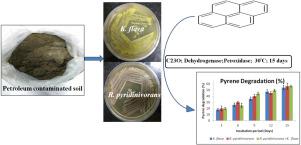Environmental Technology & Innovation ( IF 7.1 ) Pub Date : 2021-07-02 , DOI: 10.1016/j.eti.2021.101744 Sakshi 1 , S.K. Singh 1 , A.K. Haritash 1

|
Polycyclic aromatic hydrocarbons (PAHs) with high molecular weight are difficult to degrade owing to their chemical structure and stability. This study reports degradation of pyrene by two potent Gram-positive bacterial strains isolated from petroleum-contaminated soil from Bijwasan supply location of Bharat Petroleum Corporation Limited (BPCL), India. The bacteria were identified as Kocuria flava and Rhodococcus pyridinivorans based on 16S rRNA gene sequencing. The degradation of pyrene, enzyme activity of Catechol 2,3-dioxygenase (C23O), dehydrogenase and peroxidase, and the rate kinetics of degradation were investigated using the isolated bacteria. K. flava and R. pyridinivorans could degrade pyrene with an efficiency of 53.8% and 56.2%, within 15 days of incubation period under laboratory conditions. The consortium revealed 56.4% degradation of pyrene indicating that there is no synergistic/inhibitive effect. The activity (maximum on 9th day of incubation) of peroxidase enzyme (9.4 x10−4 and 16.9 x10−4 M/ml/min) was followed by dehydrogenase (2.6 x10−4 and 2.3 x10−4 M/ml/min) and C23O (2.2 x10−4 and 2.8 x10−4 M/ml/min) for K. flava and R. pyridinivorans, respectively, suggesting their involvement in ring-cleavage, diol-formation and subsequent oxidation of the intermediates. Analysis of rate kinetics exhibited degradation of pyrene to be the first order reaction indicating that an increase in initial concentration of pyrene will not compromise with the ability of studied bacteria towards degradation. Analysis of initial and final concentration of treated media over HPLC confirmed significant pyrene degradation within 15 days The study concludes that K. flava and R. pyridinivorans can play an active role in remediation of hydrocarbon-contaminated sites.
中文翻译:

从污染土壤中分离的新型细菌菌株对芘降解的分解代谢酶活性和动力学
高分子量的多环芳烃 (PAH) 由于其化学结构和稳定性而难以降解。本研究报告了从印度 Bharat Petroleum Corporation Limited (BPCL) 的 Bijwasan 供应地点的石油污染土壤中分离出的两种有效革兰氏阳性细菌菌株对芘的降解。基于16S rRNA基因测序,该细菌被鉴定为Kocuria flava和Rhodococcus pyridinivorans。使用分离的细菌研究芘的降解、儿茶酚 2,3-双加氧酶 (C23O)、脱氢酶和过氧化物酶的酶活性以及降解速率动力学。K. flava和R. pyridinivorans在实验室条件下,在 15 天的潜伏期内,能以 53.8% 和 56.2% 的效率降解芘。该财团揭示了 56.4% 的芘降解,表明没有协同/抑制作用。过氧化物酶(9.4 x10 -4和 16.9 x10 -4 M/ml/min)之后是脱氢酶(2.6 x10 -4和 2.3 x10 -4 M/ml/min) 和 C23O (2.2 x10 -4和 2.8 x10 -4 M/ml/min) 分别用于K. flava和R. pyridinivorans,表明它们参与了中间体的环裂解、二醇形成和随后的氧化。速率动力学分析表明芘的降解是一级反应,表明芘初始浓度的增加不会影响所研究细菌的降解能力。通过 HPLC 对处理过的介质的初始和最终浓度进行分析证实,芘在 15 天内显着降解。研究得出结论,K. flava和R. pyridinivorans可以在修复碳氢化合物污染场地方面发挥积极作用。



























 京公网安备 11010802027423号
京公网安备 11010802027423号